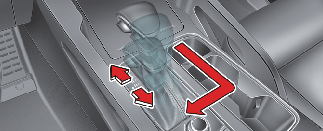Transmission ranges
P (Park)
Always come to a complete stop before shifting into P (Park). This position locks the transmission and prevents the front wheels from rotating.

-
Shifting into P (Park) while the vehicle is in motion will cause the drive wheels to lock which will cause you to lose control of the vehicle and possibly damage the transmission.
-
Do not use the P (Park) position in place of the parking brake. Always make sure the shift lever is latched in the P (Park) position and set the parking brake fully.
-
Never leave a child unattended in a vehicle.

The transmission may be damaged if you shift into P (Park) while the vehicle is in motion.
R (Reverse)
Use this position to drive the vehicle backward.

Always come to a complete stop before shifting into or out of R (Reverse); you may damage the transmission if you shift into R while the vehicle is in motion, except as explained in "Rocking the vehicle" in this section.
N (Neutral)
When in Neutral, wheels and transmission are not engaged. The vehicle will roll freely even on the slightest incline unless the parking brake or service brakes are applied.

Do not drive with the shift lever in N (Neutral). The engine brake will not work and could lead to an accident.

Always park the vehicle in "P" (Park) for safety and engage the parking brake.
D (Drive)
This is the normal forward driving position. The transmission will automatically shift through an 8-gear sequence providing the best fuel economy and power.

Always come to a complete stop before shifting into D (Drive).
Manual mode
Whether the vehicle is stationary or in motion, Manual mode is selected by pushing the shift lever from the D (Drive) position into the manual gate. To return to D (Drive) range operation, push the shift lever back into the main gate.

In Manual mode, moving the shift lever backwards or forwards will allow you to make gearshifts rapidly. In contrast to a manual transmission, the Manual mode allows gearshifts with the accelerator pedal depressed.
-
Up (+): Push the lever forward once to shift up one gear.
-
Down (-): Pull the lever backwards once to shift down one gear.

-
In Manual mode, the driver must execute upshifts in accordance with road conditions, being careful to keep the engine speed below the red zone.
-
In Manual mode, only the 8 forward gears can be selected. To reverse or park the vehicle, move the shift lever to the R (Reverse) or P (Park) position as required.
-
In Manual mode, downshifts are made automatically when the vehicle slows down. When the vehicle stops, 1st gear is automatically selected.
-
In Manual mode, when the engine rpm approaches the red zone, shift points are varied to upshift automatically.
-
To maintain the required levels of vehicle performance and safety, the system may not execute certain gearshifts when the shift lever is operated.
-
When driving on a slippery road, push the shift lever forward into the + (up) position. This causes the transmission to shift into the 2nd gear which is better for smooth driving on a slippery road. Push the shift lever to the - (down) side to shift back to the 1st gear.
-
When Manual mode is activated:
-
The engine rpm will tend to remain raised over a certain length of time even after releasing the accelerator.
-
Upshifts are delayed when accelerating.
-
-
In Manual mode, the fuel efficiency may decrease.